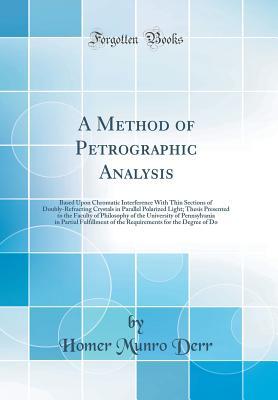Download A Method of Petrographic Analysis: Based Upon Chromatic Interference with Thin Sections of Doubly-Refracting Crystals in Parallel Polarized Light; Thesis Presented to the Faculty of Philosophy of the University of Pennsylvania in Partial Fulfillment of Th - Homer Munro Derr file in ePub
Related searches:
A Method for Analyzing the Composition of Petrographic Thin
A Method of Petrographic Analysis: Based Upon Chromatic Interference with Thin Sections of Doubly-Refracting Crystals in Parallel Polarized Light; Thesis Presented to the Faculty of Philosophy of the University of Pennsylvania in Partial Fulfillment of Th
Petrographic tests - The Concrete Society
ISO/DIS 7404-4(en), Methods for the petrographic analysis of
PROCEDURE FOR THE PETROGRAPHIC ANALYSIS OF COARSE AGGREGATE
A Petrographic Analysis of Soapstone in the American Southeast
Oct 15, 2013 exploration technique: petrography analysis petrography analysis: petrology is the study of rocks.
The principles of petrographic analysis are learned through college-level course work.
Physical and mineralogical methods used in the study of rocks and minerals constitute petrographic methods.
In petrographic analysis techniques, cast thin section, x-ray diffraction, and scanning electron microscope are most widely used; electronic probe analysis is also.
Dec 9, 2014 petrography is a branch of geology that is applied to concrete and concrete raw materials.
Part 1: specific gravity, separation and determination of minerals�.
Basic petrographic analysis is performed in transmitted light using a polarizing microscope. Certain petrographic problems require the use of a cathodoluminescence (cl) microscope (see sem, xrd, cl, and xf methods).
Mar 1, 2012 polarized light microscopy of stone and ceramics, known as thin-section petrography, is a crucial tool for the study of ancient and historic objects.
Petrographic testing is the use of microscopes to examine samples of rock or concrete to determine their mineralogical and chemical characteristics.
The petrographic analysis is a systematic description method for rocks, minerals and other constituents, usually in hand specimens, thin sections or by use of other.
What is the geological provenance of the stone? test methods we perform include: petrographic analysis (astm c856) - a microstructural examination by optical.
Petrography is also the only accepted method to determine if concrete is undergoing progressive deterioration from mechanisms such as alkali-silica reaction, sulfate attack, chemical attack, corrosion, early freezing, freeze-thaw damage, and more.
Petrographic analysis (astm c856) - a microstructural examination by optical and scanning electron microscopy (sem) of the paste and aggregate on a prepared sample of concrete to look for features such as degree of cement hydration, microcracking, reaction products, breakdown of aggregate and evidence of poor freeze-thaw performance.
Petrographic methods ofexamining hardened concrete: of the air-void system), percentage analysis of solid components, examination with.
This test method involves a combination of chemical and petrographic analysis per astm c856, thereby allowing our petrographers to identify the composition and proportions of the sample's constituents and ultimately the type of mortar (m, n, s and o) as described in astm c270, specification for mortar for unit masonry.
A method of petrographic analysis [munro, derr homer] on amazon.
To determine the cause of a structural failure or to help identify potential deficiencies, we perform petrographic analysis on concrete industrial structures.
Dec 18, 2019 a petrographic microscope is a type of optical microscope used to identify rocks and minerals in thin sections.
The recognition and content analysis of the components in petrographic thin section image is a valuable study in geology. In this paper, we propose a two-stage method to segmentation and recognition of petrographic thin section image.
Petrography is a branch of geology that is applied to concrete and concrete raw materials. This technique examines and evaluates the optical properties and microstructural characteristics of the materials. Petrographic analysis for concrete begins by accepting an aggregate for use in concrete (astm c295).
Petrographic analysis is carried out first based on core data, geochemical analysis, and thin section information. This is followed by the identification and classification of volcanic rocks using the “component + texture + genesis” scheme. 2 lithological identification of volcanic rocks based on well logs.
Scope the micro-petrographic description of rocks for engineering purposes includes the determination of all parameters which cannot be obtained from a macro- scopic examination of a rock sample, such as mineral.
Using petrography, the mineralogical variability of each set of samples was determined and then compared. Petrography is a method of analysis that uses a petrographic microscope to identify the mineral composition of rocks. Polarized light is passed through thin sections of a g iven rock, revealing the optical properties of the minerals.
Analysis of microscopic fluid inclusions within mineral grains with a heating stage on a petrographic microscope provides clues.
A method of petrographic analysis, based upon chromatic interference with thin sections of doubly-refracting crystals in parallel polarized light [derr, homer munro] on amazon.
Petrography has come to mean the description and classification of rock by any means?from simply describing the color or form to using highly technical chemical.
3 this guide may form the basis for establishing arrangements between a purchaser of consulting petrographic service and the petrographer. In such a case, the purchaser and the consultant should together determine the kind, extent, and objectives of the examination and analyses to be made, and should record their agreement in writing.
Test method title petrographic analysis reference number isrm material. The petrographic analysis of rocks for engineering purposes includes the microscopic examination of a polished thin section of rock.
C 295, standard guide for petrographic analysis of aggregates for concrete. 3 mto test methods� ls-282, method of test for quantitative extraction of asphalt cement and analysis of extracted aggregate from bituminous paving mixtures.
Description of test the petrographic analysis of rocks for engineering purposes includes the microscopic examination of a polished thin section of rock. It is used to determine the mineral content, grain size, texture and other features that have a bearing on the mechanical behavior of a rock specimen.

Post Your Comments: